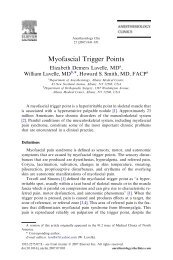Efficacy of 904 nm gallium arsenide low level laser therapy in the ...
Efficacy of 904 nm gallium arsenide low level laser therapy in the ...
Efficacy of 904 nm gallium arsenide low level laser therapy in the ...
Create successful ePaper yourself
Turn your PDF publications into a flip-book with our unique Google optimized e-Paper software.
230 GUR ET AL.<br />
mized controlled trials with results <strong>in</strong> favor <strong>of</strong> LLLT is by far<br />
too large to be expla<strong>in</strong>ed by random chance alone [10].<br />
Recently, <strong>in</strong> a systematic review by Bjordal et al. [12],<br />
<strong>the</strong>y stated that <strong>the</strong> results are conflict<strong>in</strong>g <strong>in</strong> different<br />
studies and may depend on <strong>the</strong> method <strong>of</strong> application and<br />
o<strong>the</strong>r features <strong>of</strong> <strong>the</strong> LPLT application <strong>in</strong> chronic jo<strong>in</strong>t<br />
disorders. Authors, <strong>in</strong> <strong>the</strong>ir review, stated that LLLT with<br />
<strong>the</strong> suggested dose range significantly reduces pa<strong>in</strong> and<br />
improved health status <strong>in</strong> chronic jo<strong>in</strong>t disorders, but <strong>the</strong><br />
heterogeneity <strong>in</strong> patient samples, treatment procedures,<br />
and trial design calls for cautious <strong>in</strong>terpretation <strong>of</strong> <strong>the</strong><br />
results.<br />
In recent studies, many authors have reported significant<br />
pa<strong>in</strong> reduction with LLLT <strong>in</strong> acute and chronic pa<strong>in</strong>ful<br />
conditions such as rheumatoid arthritis (830 <strong>nm</strong> Ga-As-Al)<br />
[13], cervical osteoarthritis (830 <strong>nm</strong> Ga-As-Al) [14],<br />
knee osteoarthritis (<strong>904</strong> <strong>nm</strong> Ga-As) [15], fibromyalgia<br />
(<strong>904</strong> <strong>nm</strong> Ga-As) [16,17], postoperative pa<strong>in</strong> (<strong>low</strong> <strong>in</strong>tensity<br />
1.06 microm neodymium: yttrium-alum<strong>in</strong>um-garnet <strong>laser</strong><br />
emitted 542 mW/ cm 2 ) [18], and <strong>low</strong>-back pa<strong>in</strong> (<strong>904</strong> <strong>nm</strong><br />
Ga-As) [19]. However, some have failed to show such an<br />
effect <strong>in</strong> pa<strong>in</strong>ful musculoskeletal pathologies such as<br />
epicondylitis (830 <strong>nm</strong> Ga-Al-As) [20], plantar fasciitis<br />
(830 <strong>nm</strong> Ga-Al-As) [21], and my<strong>of</strong>ascial pa<strong>in</strong> <strong>in</strong> <strong>the</strong> neck<br />
(830 <strong>nm</strong> Ga-Al-As) [22]. The equipment, experimental<br />
designs, and techniques used <strong>in</strong> <strong>the</strong> <strong>low</strong>-energy <strong>laser</strong><br />
literature are highly variable, and close attention should<br />
be paid to <strong><strong>the</strong>rapy</strong> parameters when review<strong>in</strong>g and compar<strong>in</strong>g<br />
<strong>the</strong>se studies. Still, <strong>the</strong> efficacy <strong>of</strong> this <strong><strong>the</strong>rapy</strong><br />
method is controversial.<br />
There are few studies <strong>of</strong> LLLT for neck pa<strong>in</strong>. Those that<br />
exist describe <strong>the</strong> use <strong>of</strong> different wavelengths such as<br />
830 <strong>nm</strong> Ga-Al-As [14], Cecherelli (pulsed <strong>in</strong>frared diode<br />
<strong>laser</strong>) [23] and 630 <strong>nm</strong> He–Ne [24] <strong>in</strong> <strong>the</strong> management <strong>of</strong><br />
chronic pa<strong>in</strong> and describe treatment <strong>of</strong> acute ra<strong>the</strong>r than<br />
chronic pa<strong>in</strong> (<strong>904</strong> <strong>nm</strong> Ga-As) [25].<br />
Thus, a prospective, double-bl<strong>in</strong>d, randomized, and<br />
controlled trial was conducted <strong>in</strong> patients with MPS <strong>in</strong><br />
<strong>the</strong> neck to evaluate <strong>the</strong> effects <strong>of</strong> LLLT on cl<strong>in</strong>ical and QoL.<br />
SUBJECTS AND METHODS<br />
Subjects<br />
Of <strong>the</strong> total 148 patients referred for <strong>the</strong> first assessment,<br />
69 did not meet <strong>the</strong> <strong>in</strong>clusion criteria and 19 subjects<br />
refused to participate; 60 patients were <strong>in</strong>cluded <strong>in</strong> <strong>the</strong> trial<br />
(Fig. 1).<br />
The diagnosis <strong>of</strong> MPS was based on <strong>the</strong> fol<strong>low</strong><strong>in</strong>g criteria:<br />
(1) presence <strong>of</strong> a tender spot characterized by spontaneous<br />
pa<strong>in</strong> or associated with movement <strong>of</strong> <strong>the</strong> right or left<br />
superior trapezius muscle; (2) reproduction or enhancement<br />
<strong>of</strong> <strong>the</strong> cl<strong>in</strong>ical symptoms by compression <strong>of</strong> <strong>the</strong> active<br />
TP; (3) presence <strong>of</strong> a palpable taut band peripherally to <strong>the</strong><br />
TP. Non-essential criteria considered <strong>in</strong> diagnosis were;<br />
presence <strong>of</strong> spontaneous referred pa<strong>in</strong> <strong>in</strong> parts <strong>of</strong> <strong>the</strong> body<br />
o<strong>the</strong>r than <strong>the</strong> superior trapezius muscle; elicitation <strong>of</strong><br />
referred pa<strong>in</strong> by compression <strong>of</strong> <strong>the</strong> active TP; weakness<br />
<strong>of</strong> <strong>the</strong> trapezius muscle; restricted range <strong>of</strong> motion <strong>of</strong> <strong>the</strong><br />
cervical sp<strong>in</strong>e; palpable or local twitch response upon<br />
Fig. 1. Trial pr<strong>of</strong>ile.<br />
snapp<strong>in</strong>g palpation <strong>of</strong> <strong>the</strong> most sensitive spot <strong>in</strong> <strong>the</strong> taut<br />
band.<br />
After an exam<strong>in</strong>ation by a physician, <strong>the</strong> patients were<br />
<strong>in</strong>cluded <strong>in</strong> <strong>the</strong> study if <strong>the</strong>y fulfilled <strong>the</strong> fol<strong>low</strong><strong>in</strong>g criteria:<br />
(1) age 17–55 years; (2) pa<strong>in</strong> from <strong>the</strong> neck and shouldergirdle<br />
last<strong>in</strong>g at least 1 year, affect<strong>in</strong>g <strong>the</strong> quality <strong>of</strong> work or<br />
daily liv<strong>in</strong>g; (3) between one and ten tender po<strong>in</strong>ts <strong>in</strong> <strong>the</strong><br />
shoulder-girdle, tender po<strong>in</strong>ts that on palpation <strong>in</strong>duced<br />
reproduction <strong>of</strong> <strong>the</strong> reported symptoms.<br />
Major cl<strong>in</strong>ical conditions o<strong>the</strong>r than MPS were excluded<br />
by physical exam<strong>in</strong>ation and rout<strong>in</strong>e whole blood cells<br />
count<strong>in</strong>g, hematocrit, hemoglobul<strong>in</strong>, basel<strong>in</strong>e thyroidstimulat<strong>in</strong>g<br />
hormone, and ant<strong>in</strong>uclear autoantibodies<br />
studies. The fol<strong>low</strong><strong>in</strong>g patients were excluded from <strong>the</strong><br />
study: (1) patients with signs and symptoms <strong>of</strong> fibromyalgia;<br />
(2) patients aged be<strong>low</strong> 17 or above 55 years; (3)<br />
patients with mental retardation; (4) patients with neurological<br />
deficits <strong>in</strong>volv<strong>in</strong>g <strong>the</strong> upper limbs; (5) patients<br />
with advanced osteopathic or arthropathic disorder <strong>of</strong> <strong>the</strong><br />
cervical sp<strong>in</strong>e or <strong>the</strong> shoulder <strong>of</strong> <strong>the</strong> <strong>in</strong>vestigated side.<br />
Fur<strong>the</strong>rmore, we excluded patients present<strong>in</strong>g contra<strong>in</strong>dications<br />
for <strong>the</strong> adm<strong>in</strong>istered <strong>the</strong>rapies, namely, patients<br />
suffer<strong>in</strong>g from cardiovascular disease, hypertension, coagulopathy,<br />
ulcer, recent severe hemorrhage, renal <strong>in</strong>sufficiency,<br />
severe hepatic disease, neoplasia, epilepsy,<br />
cutaneous pathology or pa<strong>in</strong> <strong>of</strong> central orig<strong>in</strong>, and pregnant<br />
women.<br />
An orthopaedic surgeon, who had excluded orthopaedic<br />
disease as a cause <strong>of</strong> <strong>the</strong> pa<strong>in</strong>, had exam<strong>in</strong>ed all patients.<br />
Rheumatic or o<strong>the</strong>r <strong>in</strong>flammatory diseases had been<br />
excluded by laboratory test procedures and cl<strong>in</strong>ical exam<strong>in</strong>ation.<br />
All subjects were free <strong>of</strong> any <strong>in</strong>fections, <strong>in</strong>flammatory<br />
or allergic reactions for at least 2 weeks prior to <strong>the</strong><br />
blood sampl<strong>in</strong>g and free <strong>of</strong> drugs known to affect immune or<br />
endocr<strong>in</strong>e functions and <strong>of</strong> hormonal preparations. Each<br />
patient had normal f<strong>in</strong>d<strong>in</strong>gs on radiographs <strong>of</strong> <strong>the</strong> chest,<br />
hands, feet, and sacroiliac jo<strong>in</strong>ts. Each patient had been




